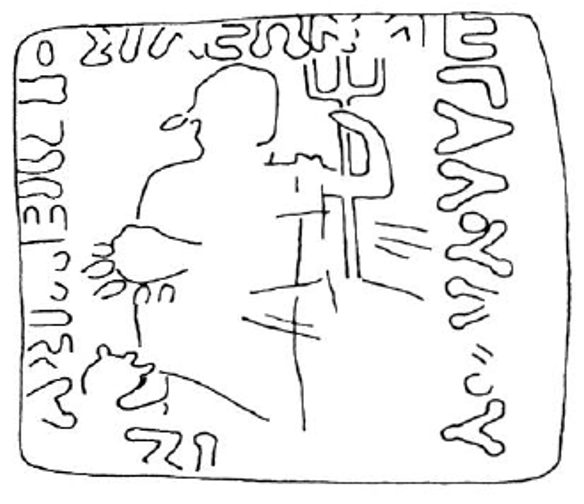58 BCE - 12 BCEΒΑΣΙΛΕΩΣ ΒΑΣΙΛΕΩΝ ΜΕΓΑΛΟΥ ΑΖΟΥ | Maharajasa rajarajasa mahatasa Ayasa (of Great King, King of Kings Azes the Great)
Overstriking coin
SO_2121_-_Gandhara-Punjab_(uncertain_mint)_(Azes_I).png
Overstruck variety
Apollodotus Apollo bow arrow-tripod.jpeg
[1]
Description
| ObverseInscription or printing placed on the obverse.:
|
ΒΑΣΙΛΕΩΣ ΒΑΣΙΛΕΩΝ ΜΕΓΑΛΟΥ ΑΖΟΥ (Greek) Poseidon facing, one foot on divinity (river god), holding trident
|
ReverseInscription or printing placed on the reverse.:
|
Maharajasa rajarajasa mahatasa Ayasa (of Great King, King of Kings Azes the Great) (Kharoshthi) Yakshi facing, holding sceptre. Inbackground, vines. In left field, monogram.
|
Mint and issuing power
| MintIdentifies the place of manufacture or issue of a numismatic object.:
|
Taxila
|
Ancient regionAncient region.
|
Gandhara
|
Modern countryModern country: Afghanistan
|
AuthorityIdentifies the issuing power. The authority can be "pretended" when the name or the portrait of X is on the coin but he/she was not the issuing power. It can also be "uncertain" when there is no mention of X on the coin but he/she was the issuing power according to the historical sources:
|
|
Chronology
| FromIdentifies the initial date in a range assigned in a numismatic context. 58 BCE toIdentifies the final date in a range assigned in a numismatic context.. 12 BCE
|
Hellenistic 323-30 BC  periodTime period of the numismatic object. periodTime period of the numismatic object.
|
Physical description
MetalThe physical material (usually metal) from which an object is made.: Bronze 
|
|
DenominationTerm indicating the value of a numismatic object. Examples: tetradrachm, chalkous, denarius.: denomination A
|
|
|
|
StandardStandard.: Indian (Hoover)
|
References
| Coin referenceReference of the Coin:
|
Whitehead 1914, p. 123, n° 244, Bopearachchi 1989, p. 76-77, n° 22, pl. VI, Bopearachchi 2008, p. 261
|
Coin series referenceReference to coin series study:
|
Mitchiner 19751Mitchiner 1975, p. 492, type 740, Senior 20012Senior 2001, vol. 2, p. 31-32, n° 77, HGC 123HGC 12, n° 674
|
Description
| ObverseInscription or printing placed on the obverse.:
|
ΒΑΣΙΛΕΩΣ ΣΩΤΗΡΩΣ ΑΠΟΛΛΟΔΟΤΟΥ (Greek) Apollo standing facing, holding bow and arrow (visible on obverse: head and body of Apollo, arrow, legend)
|
ReverseInscription or printing placed on the reverse.:
|
Maharajasa tratarasa Apaladatasa (of Great King Apollodotus the Savor) (Kharoshthi) Tripod. In left field, monogram. In right field, Kharoshthi letter (nothing visible on reverse)
|
Mint and issuing power
Chronology
| FromIdentifies the initial date in a range assigned in a numismatic context. 80 BCE toIdentifies the final date in a range assigned in a numismatic context.. 65 BCE
|
Hellenistic 323-30 BC  periodTime period of the numismatic object. periodTime period of the numismatic object.
|
Physical description
| DenominationTerm indicating the value of a numismatic object. Examples: tetradrachm, chalkous, denarius. ᵖ:
|
denomination A
|
StandardStandard. ᵖ:
|
Indian (Hoover)
|
References
References
- a b Mitchiner, Michael (1975), Indo-Greek and Indo-Scythian coinage, London,
- ^ Senior, Robert C. (2001), Indo-Scythian Coins and History, 4 vol., Lancaster, Penn. ; London, Classical Numismatic Group.
- a b Hoover, Oliver D. (2013), Handbook of coins of Baktria and ancient India : including Sogdiana, Margiana, Areia, and the Indo-Greek, Indo-Skythian, and native Indian states south of the Hindu Kush, fifth century BC to first century, Lancaster-London,
- ^ Bopearachchi, Osmund (1991), Monnaies gréco-bactriennes et indo-grecques : catalogue raissoné, Paris, 459 p., 69 pl.


